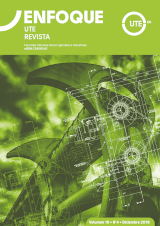Evaluation of a wireless Broadband Network for VoIP in Huaytará
DOI:
https://doi.org/10.29019/enfoque.v10n4.513Palabras clave:
Red de transporte, red de acceso, planificación de la red Wlan.Resumen
Consiste en diseñar y evaluar el rendimiento de una red inalámbrica de banda ancha en la provincia de Huaytará, para la conectividad a internet. Es una investigación aplicada y experimental donde se evaluó los parámetros de rendimiento de la red. La variable dependiente es la capacidad de la celda Wlan y los parámetros de QoS; y como variables independientes la cobertura y la densidad de la red Wlan. Se puede afirmar que para radios de hasta 8 metros, la tasa de datos del cliente experimental es superior a la tasa de datos del cliente control, y para radios mayores a 15 metros, las tasas de datos del cliente experimental y control no son diferentes. En cuanto a los parámetros de QoS, son favorables para las aplicaciones multimedia. La red implementada con tecnología TDM-E1/Ethernet e IEEE 802.11n, tiene una capacidad máxima por celda de 32.5 Mbps en la banda de 2.4G y de 65 Mbps en la banda de 5.8G, considerando parámetros de operación mínimo de los dispositivos inalámbricos. Los usuarios tienen un tasa de datos en campo de 15.2 Mbps para una radio máximo de 8 metros con hasta 7 usuarios inalámbricos conectados en la celda, en 2.4 Ghz.
Descargas
Referencias
Barrenechea, Taylor (2011). Diseño de una red inalámbrica para una empresa de Lima, Tesis de grado, Pontificia Universidad Católica del Perú.
Briones, Emilio (2015). Simulación y evaluación de redes Wifi mediante la plataforma Opnet. Universidad católica de Santiago de Guayaquil.
Cabezas, L., y González, F. (2010). Redes Inalámbricas, Madrid: Anaya Multimedia.
Figueroa, M. (2008). Redes de Área Local Inalámbricas, NY: McGraw-Hill.
Forero, C., Moreno, A., y Sierra, L. (2011). Análisis de radiopropación con antenas microceldas, Gerencia Tecnológica informative, vol. 10 N° 27, pp. 35-48, Universidad Industrial de Santander.
Gómez, J. (2006). Nueva Tecnología para Redes Inalámbricas Wi-Fi. Universidad Autónoma del Estado de Hidalgo.
Gómez, B., Maimó, J., y Merideño, J. (2010). Wireless Mesh Networks, 2010. Enginy@eps Nº 2, ISSN:1889-4771.
Hernández, L. (2007). Estudio del impacto de IEEE802.11n sobre las redes wireless en el Perú. Pontificia Universidad Católica del Perú.
INEI (2017). Perfil Sociodemográfico del Departamento de Huancavelica, Lima.
Murillo, J. (2015). Diseño e implantación de una red inalámbrica unificada en el Colegio Nuestra Señora de Fátima de Valencia. Universidad politécnica de Valencia.
Paredes, C. y Cayo, J. (2013). Las barreras al crecimiento económico en Huancavelica, Lima.
Taveras, B. (2013). Propuesta de Diseño e Implementación de la Red Wi-Fi del Campus Universitario UCNE. Universidad Católica Nordestana.
Ubiquiti Networks (2017). Administrador de Redes Inalámbricas Empresariales de Ubiquiti-UEWA.
Vela, P. (2015). Estudio y diseño de un radioenlace para transmisión de datos, e internet en frecuencia libre para la cooperativa indígena “Alfa y Omega” utilizando equipos Airmax de Ubiquiti. Escuela Politécnica Nacional, Ecuador.
Zhai, H., Wang, J. y Fang, Y. (2006). Providing statistical QoS guarantee for voice over IP in the IEEE 802.11 wireless LANs, IEEE Wireless Communications, vol. 13, no. 1, pp. 36 – 43, DOI: 10.1109/MWC.2006.1593523
Publicado
Número
Sección
Licencia
Derechos de autor 2019 Enfoque UTE

Esta obra está bajo una licencia Creative Commons Reconocimiento 3.0 Unported.
Los autores retienen todos sus derechos (© copyright).
- Los autores retienen sus derechos de marca y patente, y también sobre cualquier proceso o procedimiento descrito en el artículo.
- Los autores retienen el derecho de compartir, copiar, distribuir, ejecutar y comunicar públicamente el artículo publicado en Enfoque UTE (por ejemplo, colocarlo en un repositorio institucional o publicarlo en un libro), siempre que se dé el reconocimiento de su publicación inicial en la revista Enfoque UTE.
- Los autores retienen el derecho a hacer una posterior publicación de su trabajo, de utilizar el artículo o cualquier parte de aquel (por ejemplo: una compilación de sus trabajos, notas para conferencias, tesis, o para un libro), siempre que indiquen la fuente de publicación (autores del trabajo, revista, volumen, número y fecha).
























